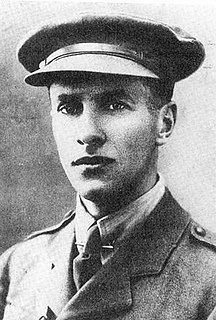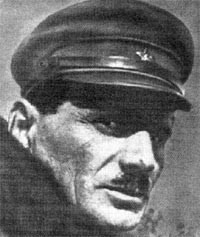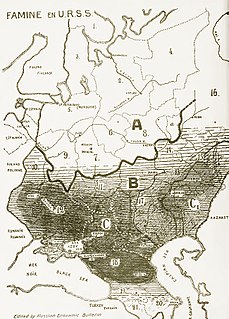Background
Immigration
In the first eight months of 1931, a Soviet trade agency in New York advertised 6,000 positions and received more than 100,000 applications. Ten thousand Americans were hired in 1931, part of the official "organized emigration". [1] [2] [3] [4]
In February 1931, The New York Times reported:
...[The soviet immigration] was the greatest wave of immigration in modern history...The Soviet Union will witness in the next few years an immigration flood comparable to the influx into the United States in the decade before the World War...It is only the beginning as yet of this movement, and the first swallows of the coming migration are scarce—but it has begun and will have to be reckoned with in the future....When the day comes that foreign workers here may write home and say, 'Things are pretty good here, why don't you come along? There are jobs for everybody and plenty to eat. Russia is not so bad a place in which to live and there are no lay-of s or short time and you get all that is coming to you' . . . Then immigration to the Soviet Union will begin to rival the flood that poured into America. At the present rate of progress that day is not far distant. [5]
In March 1932, The New York Times reported that immigration to the Soviet Union was 1000 a week, but increasing. [6]
Soon, an official edict was issued that in the future all Americans must carry a round-trip ticket and would no longer be given jobs, simply because there was not enough space to house them all. Moscow and all the major Russian cities were already overcrowded. [4]
The Foreign Workers' Club of Moscow baseball team, a group of Americans, played regular games in Gorky Park. [7]
In the summer of 1932, the Soviet Supreme Council of Physical Culture announced its decision to introduce baseball to the Soviet Union as a "national sport". [4]
The American immigrants opened an Anglo-American school in Moscow, with 125 pupils on the register by November 1932, three quarters of them born in the United States. Over the next three years, enrollment rose so high that the Anglo-American school moved into a larger school, School Number 24 on Great Vuysovsky Street. [4]
Gulag Imprisonment and Executions
By 1937, many of the Americans were arrested alongside untold numbers of other Americans. Some were executed. Others were sent to "corrective labor" camps in the gulag where they were worked to death. [8] For two more generations the Americans were prosecuted.
World War 2 POWs in Russia
Thousands of American Prisoners of War from World War 2 were reported in the USSR. For example, 119 American prisoners of war were held back by Stalin, because their names had “Russian, Ukrainian or Jewish” origins. Although most of these prisoners were later released after United States protests, 18 died in Soviet custody and “some ended up staying in camps for a long time.”
In a 1992 letter, Boris Yeltsin stated that nine US planes had been shot down in the early 1950s and 12 Americans had been held prisoners. [9] As a result, in March 1992, a joint Russian American Task Force Russia was created to review these cases. [10] [11] [12] [13] Dmitri Volkogonov, a former Soviet general and co-chairman of the Task Force Russia told a US Senate Committee that 730 airmen had been captured on Cold War spy flights. [14]

The Gulag was the government agency which was in charge of the Soviet network of forced-labour camps which was set up by order of Vladimir Lenin. It reached its peak during Joseph Stalin's rule from the 1930s to the early 1950s. English-language speakers also use the word gulag to refer to all forced-labour camps which existed in the Soviet Union, including camps which existed in the post-Stalin era. The camps housed a wide range of convicts, from petty criminals to political prisoners. Large numbers were convicted by simplified procedures, such as by NKVD troikas or by other instruments of extrajudicial punishment. The Gulag is recognised as a major instrument of political repression in the Soviet Union.
Stalinism is the means of governing and related policies implemented from 1927 to 1953 by Joseph Stalin (1878–1953). Stalinist policies and ideas that were developed in the Soviet Union included rapid industrialization, the theory of socialism in one country, a totalitarian state, collectivization of agriculture, a cult of personality and subordination of the interests of foreign communist parties to those of the Communist Party of the Soviet Union, deemed by Stalinism to be the leading vanguard party of communist revolution at the time.

Kolyma is a region located in the Russian Far East. It is bounded by the East Siberian Sea and the Arctic Ocean in the north and the Sea of Okhotsk to the south. The region gets its name from the Kolyma River and mountain range, parts of which were not discovered by Russians until 1926. Today the region consists roughly of the Chukotka Autonomous Okrug and the Magadan Oblast.

Walter Duranty was a Liverpool born Anglo-American journalist who served as the Moscow Bureau Chief of The New York Times for fourteen years (1922–1936) following the Bolshevik victory in the Russian Civil War (1918–1921).

Naftaly Aronovich Frenkel was a Jewish Bolshevik and member of the Cheka Soviet secret police. Frenkel is best known for his role in the organisation of work in the Gulag, starting from the forced labor camp of the Solovetsky Islands, which is recognised as one of the earliest sites of the Gulag.
Throughout the history of the Soviet Union, millions of people suffered political repression, which was an instrument of the state since the October Revolution. It culminated during the Stalin era, then declined, but it continued to exist during the "Khrushchev Thaw", followed by increased persecution of Soviet dissidents during the Brezhnev stagnation, and it did not cease to exist until late in Mikhail Gorbachev's rule when it was ended in keeping with his policies of glasnost and perestroika.

The first five-year plan of the Union of Soviet Socialist Republics (USSR) was a list of economic goals, created by Communist Party General Secretary Joseph Stalin, based on his policy of Socialism in One Country. The plan was implemented in 1928 and took effect until 1932.

The Soviet famine of 1932–33 was a major famine that killed millions of people in the major grain-producing areas of the Soviet Union, including Ukraine, Northern Caucasus, Volga Region and Kazakhstan, the South Urals, and West Siberia. The Holodomor in Ukraine and Kazakh famine of 1932–33 have been seen as genocide committed by Joseph Stalin's government. It has been estimated that between 3.3 and 3.9 million died in Ukraine and 2 million died in Kazakhstan.

Eduard Petrovich Berzin, born in Latvia, was a soldier and Chekist, but is remembered primarily for setting up Dalstroy, which instituted a system of forced-labour camps in Kolyma, North-Eastern Siberia, where hundreds of thousands of prisoners died. It was considered to be the most brutal of all the Gulag regions.

Denial of the Holodomor is the claim that the 1932–1933 Holodomor, a man-made famine in Soviet Ukraine, did not occur or diminishing the scale and significance of the famine. Official Soviet propaganda denied the famine and suppressed information about it from its very beginning until the 1980s. It was also circulated by some Western journalists and intellectuals. It was echoed at the time of the famine by some prominent Western journalists, including The New York Times' Walter Duranty and Louis Fischer. The denial of the man-made famine was a highly successful and well orchestrated disinformation campaign by the Soviet government. According to Robert Conquest, it was the first major instance in which Soviet authorities adopted the Big Lie propaganda technique in order to sway world opinion, and it was followed by similar campaigns with regard to the Moscow Trials and the denial of the existence of the Gulag labor camp system.
Thomas Sgovio was an American artist, ex-Communist, and former inmate of a Soviet Union GULAG camp in Kolyma. His father was an Italian American communist, deported by the US authorities to the USSR because of his political activities.
Forced labor was used extensively in the Soviet Union as a means of controlling Soviet citizens and foreigners. Forced labor also provided manpower for government projects and for reconstruction after the war. It began before the Gulag and Kolkhoz systems were established, although through these institutions, its scope and severity were increased. The conditions that accompanied forced labor were often harsh and could be deadly.
John Dickinson "Jack" Littlepage was an American mining engineer. He was born in Gresham, Oregon on September 14, 1894. Littlepage was employed in the USSR from 1928 to 1937, becoming Deputy Commissar of the USSR's Gold Trust in the 1930s. He is one of the recipients of the Order of the Red Banner of Labour.
The SS Indigirka was an American built steamship that served in the Soviet Gulag system and transported prisoners. Launched in 1919 as SS Lake Galva, it served under the names Ripon, Malsah and Commercial Quaker between 1920 and 1938, when it was renamed Indigirka. On its final voyage in 1939 over 700 prisoners perished.
Ivan Fedorovich Nikishov was a Soviet NKVD Lieutenant General and director of Dalstroy.
Robert Nathaniel Robinson was a Jamaican-born toolmaker who worked in the auto industry in the United States. At the age of 23, he was recruited to work in the Soviet Union. Shortly after his arrival in Stalingrad, Robinson was racially assaulted by two white American workers, both of whom were subsequently arrested, tried and expelled from the Soviet Union with great publicity.
The People's Commissariat for Internal Affairs, abbreviated NKVD, was the interior ministry of the Soviet Union.
De-Stalinisation consisted of a series of political reforms in the Soviet Union after the death of long-time dictator Joseph Stalin in 1953, and the ascension of Nikita Khrushchev to power.

Victor Herman was a Jewish-American who spent 18 years as a Soviet prisoner in the Gulags of Siberia. He was one of thousands of Americans sympathetic towards Communism who went to the Soviet Union in the early 1930s to work but who met tragic fates during the Stalin purges. He briefly held the world record in 1934 for the highest parachute jump and became known as the 'Lindbergh of Russia'.

Estimates of the number of deaths attributable to the Soviet dictator Joseph Stalin vary widely. Some scholars assert that record-keeping of the executions of political prisoners and ethnic minorities are neither reliable nor complete, others contend archival materials contain irrefutable data far superior to sources utilized prior to 1991, such as statements from emigres and other informants.








